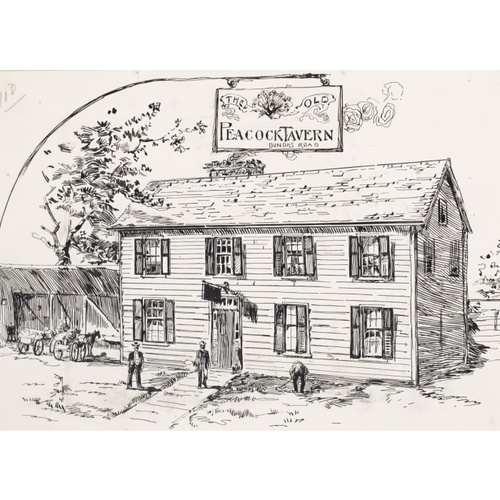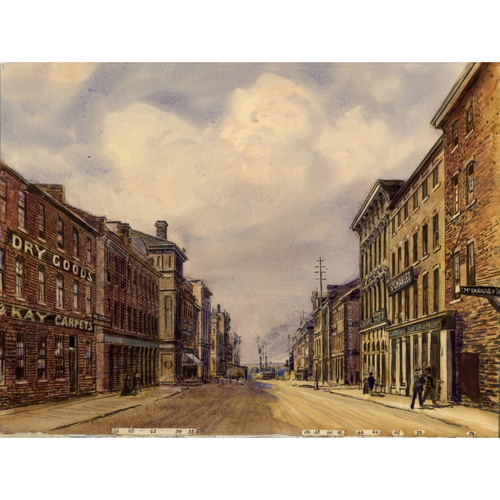![Portrait of William James Thompson. [ca. 1885] Original title: Portrait of William James Thompson. [ca. 1885]](/bioimages/w600.24956.jpg)
Source: Link
THOMSON, WILLIAM JAMES, artist; b. 28 May 1857 in Guelph, Upper Canada, son of Charles Thomson and Catharine Stewart; m. 26 June 1889 Jennie Leys (d. 7 Oct. 1922) in Sarnia, Ont., and they had a daughter and two sons, one of whom died in childhood; d. 28 April 1927 in Toronto.
William Thomson’s father was a cabinetmaker whose craft took him and his wife from Aberdeenshire, Scotland, to Guelph. The family moved to Toronto in 1860. William was apprenticed to an engraving firm, and in 1882–86 he attended the Ontario School of Art, where he received instruction from William Cruikshank and John Arthur Fraser*. In his early years his focus on engraving vignettes of buildings for business stationery and advertising helped him refine his art. The static quality of his work gave way to etchings with painterly nuancing.
In 1884 Thomson participated in the organization of the Association of Canadian Etchers. The artistic success of its exhibition of international prints the following year was offset by the show’s financial failure and the association’s demise. Dedicated to printmaking, which established artists’ societies initially shunned, Thomson moved on with others in 1886 to create the Toronto Art Students’ League, the first society in Canada to further the graphic arts by conducting life classes, exhibitions, and annual publications. Thomson was its treasurer and, in 1890–91, its president. Later he was a member of the Graphic Arts Club, formed in 1903; it too stimulated interest in prints and contributed to what art historian Rosemarie L. Tovell describes as “Canada’s etching revival,” with reference to such earlier artists as James D. Duncan*.
The collegial benefits and nationalistic flavour of the Students’ League and the Arts Club appealed to Thomson, but he was foremost a working artist. In 1886–88 he had been an engraver with Rolph, Smith and Company and in 1890–91 he worked for the Globe, covering important trials and other stories. In February 1891, for example, he illustrated iceboats skimming across Toronto Bay, slum conditions in the Ward, and club and gymnastic activities at St Andrew’s Institute. He worked as a freelancer usually – for a time his office was next to that of the Students’ League in the Imperial Bank Buildings – and within a conducive family. For several years before his death in 1894, his father was a supplier of maple and boxwood for engraving plates. From 1900 to 1913 William headed the Thomson Engraving Company, which employed his younger brothers James Stewart and David Francis and whose services included photo-engraving.
After 1910 wide acclaim came to Thomson through shows at the Canadian National Exhibition and the Winnipeg Museum of Fine Arts, the attention of such connoisseurs as Sir Byron Edmund Walker and James Mavor, and purchases by the Art Museum of Toronto and the National Gallery of Canada. His gifts as an engraver on hardwood, steel, and copper placed him in high demand as an instructor and illustrator. He travelled widely in these capacities in the United States and Canada – one dry-point from 1913, Fisherman’s harvest, is set in Vancouver – and he would remain prolific until his death. Following the motto of the Students’ League (“Non clamor sed amor”), he did much of his fine-art work for love, trading his skills for pieces by others and critiquing young artists. In 1916 he was the founding president of the Society of Canadian Painter-Etchers, a largely honorary position since much of his last ten years was spent working in Philadelphia.
Part of Thomson’s oeuvre was lost when he donated a quantity of his plates to a munitions drive during World War I. In 1926 he gave his library to the Arts and Letters Club in Toronto, where he also belonged to the freemasons and the Caer Howell Bowling Club. While visiting his son in 1927 he became ill and died at the Toronto General Hospital. Described by the Globe as the “dean of Canadian etchers,” he was buried beside his wife in Mount Pleasant Cemetery.
A collection of William James Thomson’s papers and works of art is in the possession of his grandson William D. Thomson of Bath, Ont. Examples of his work for the Globe appear in the Saturday editions of 7, 21, and 28 Feb. 1891.
AO, RG 22-305, no.10132; RG 80-5-0-187, no.6199. Globe, 30 April 1927. W. G. Colgate, The Toronto Art Students’ League, 1886–1904 (Toronto, 1954). Dict. of Toronto printers (Hulse). Directory, Toronto, 1884–1923. The encyclopedia of Canada, ed. W. S. Wallace (6v., Toronto, [1948]), 6. J. R. Harper, Early painters and engravers in Canada (Toronto, 1970). Soc. of Canadian Painter-Etchers, William J. Thomson, Canada, engraver, 1857–1927 . . . (Toronto, 1930). R. L. Tovell, A new class of art: the artist’s print in Canadian art, 1877–1920 (Ottawa, 1996).
Cite This Article
Andrew Thomson, “THOMSON, WILLIAM JAMES,” in Dictionary of Canadian Biography, vol. 15, University of Toronto/Université Laval, 2003–, accessed July 17, 2025, https://www.biographi.ca/en/bio/thomson_william_james_15E.html.
The citation above shows the format for footnotes and endnotes according to the Chicago manual of style (16th edition). Information to be used in other citation formats:
| Permalink: | https://www.biographi.ca/en/bio/thomson_william_james_15E.html |
| Author of Article: | Andrew Thomson |
| Title of Article: | THOMSON, WILLIAM JAMES |
| Publication Name: | Dictionary of Canadian Biography, vol. 15 |
| Publisher: | University of Toronto/Université Laval |
| Year of revision: | 2005 |
| Access Date: | July 17, 2025 |









